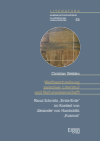Weltbeschreibung zwischen Literatur und Naturwissenschaft
Raoul Schrotts „Erste Erde“ im Kontext von Alexander von Humboldts „Kosmos“
Zusammenfassung
Mit „Erste Erde“ hat Raoul Schrott einen Text vorgelegt, der das gesamte Wissen über die Welt zu fassen versucht, – und sich so in die Tradition von Universalgelehrten wie Alexander von Humboldt, der im 19. Jahrhundert mit seinem „Kosmos“ ein ähnliches Ziel verfolgte, eingeschrieben. Dem spezialisierten 21. Jahrhundert stellt Schrott damit ein Universalepos entgegen, das Literatur und Naturwissenschaft vereint. Welches Verhältnis dieser beiden scheinbaren Antipoden manifestiert sich darin? Inwiefern stellt sich dieses Verhältnis in „Erste Erde“ anders dar als in „Kosmos“? Im Kontext der Beantwortung dieser Fragen werden Entwicklungslinien eines sich verändernden Weltbilds von der Zeit Humboldts bis in die Gegenwart aufgezeigt.
Abstract
With "Erste Erde", Raoul Schrott has presented a text that attempts to grasp the entire body of knowledge about the world - and thus inscribed himself in the tradition of polymaths such as Alexander von Humboldt, who pursued a similar goal with his "Cosmos" in the 19th century. Schrott thus opposes the specialized 21st century with a universal epic that unites literature and natural science. What relationship between these two apparent antipodes is manifested in it? To what extent is this relationship different in "Erste Erde" than in "Cosmos"? In the context of answering these questions, lines of development of a changing world view from Humboldt's time to the present are shown.
Schlagworte
19. Jahrhundert 19th century 21. Jahrhundert 21st century beginning of the world Alexander von Humboldt Entstehung der Welt cosmos Entwicklungslinien creation of the world epic Epos Erdgeschichte first earth formation of the world Erste Erde Gegenwart lines of development Kosmos literature Literatur natural science Naturwissenschaft polymath present day Raoul Schrott Universalepos universal epic Universalgelehrte world description world history Weltbeschreibung Weltbild worldview Weltgeschichte- 13–20 Einleitung 13–20
- 241–246 Schlussbetrachtung 241–246
- 247–282 Anhang 247–282

